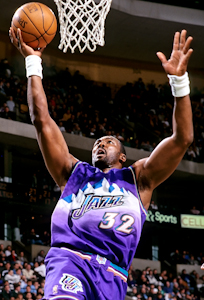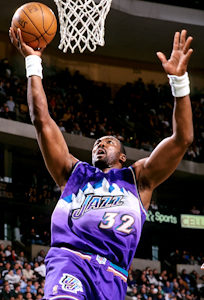Karl Malone
Karl Malone teamed with guard John Stockton while with the National Basketball Association's Utah Jazz to form perhaps the greatest guard-forward combo in league history.

Courtesy of Wikimedia Commons
Karl Malone. Steve Lipofsky @ Basketballphoto.com
Famously nicknamed “The Mailman” for his ability to deliver in the clutch, Karl Malone teamed with guard John Stockton while playing with the Utah Jazz to form perhaps the greatest guard-forward combo in National Basketball Association (NBA) history. With Stockton feeding him the ball, Malone both overpowered and outmaneuvered to become one of the most dominating power forwards in basketball. For his efforts, Malone was enshrined in the Naismith Memorial Basketball Hall of Fame in 2010.
Malone was born on July 24, 1963, and grew up on a farm in tiny Summerfield, Louisiana, in rural Claiborne Parish. He was the youngest of nine children raised by a single mother; his estranged father committed suicide when Malone was fourteen years old. As a youth, Malone developed a love of the outdoors that stayed with him throughout his life. As a basketball player at Summerfield High School, he led the team to three straight Class C state championships. He then attended college in-state, starring for Louisiana Tech from 1981 to 1985. During his collegiate career, Malone helped transform Tech into a Southland Conference champion and paced the Bulldogs to their first-ever trip to the National Collegiate Athletic Association (NCAA) Tournament in 1985.
The Utah Jazz—a franchise birthed in Louisiana as the New Orleans Jazz—chose Malone with the thirteenth overall pick in the 1985 NBA draft. Although the Jazz and Malone never won an NBA championship, they made multiple trips to the playoff finals in the 1990s. That was the same decade in which Malone won two Olympic gold medals—one in 1992 with the United States’ famous “Dream Team” and another in 1996—further burnishing his reputation for gritty play and fierce competitiveness.
Malone spent his final year in the NBA with the Los Angeles Lakers—with whom he signed as a free-agent contract in one last, ultimately futile attempt to grab an elusive NBA crown—before retiring in 1995. By then, his resumé made him one of the greatest players in basketball history: he was second on the all-time scoring list, won fourteen All-Star nods, garnered two NBA Most Valuable Player awards, and earned a place on the league’s fiftieth-anniversary all-time team. For those accomplishments, the Jazz retired Malone’s number, 32, and unveiled a statue of him at the Energy Solutions Arena in Salt Lake City in 2006. Malone continues to enjoy an eclectic retirement, donating money to candidates of both political parties, serving on the National Rifle Association’s board of directors, visiting US troops across the world, and speaking out in support of family farms.
